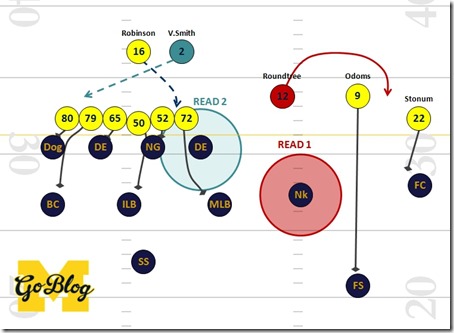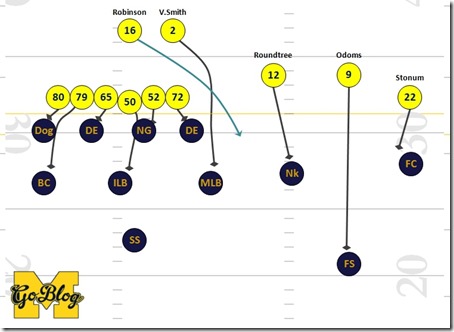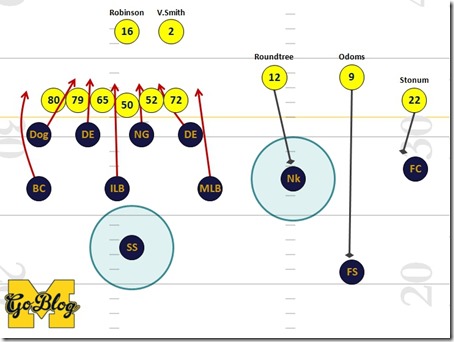The way we were
Drew Hallett has a series on MNB called "Film Focus" that's a lot like the stuff Space Coyote used to diary here, i.e. screenshots with the play drawn on them. A few weeks ago Drew called for Michigan to add a packaged bubble screen to the zone read running game that briefly resurfaced in the 1st quarter on Saturday. Then he called this a "pop pass" and referred to the QB OH NOES play from 2010.
I started a long reply to make it clear that those are really two different things from two different offensive play groups, though both are predicated on the same spread concept of using the QB to add another player to the running game. Then I made drawings. Then I had video. Then I had a Hokepoints to save for OSU week.
Interesting things people do on offense are so far from topical right now at Michigan, but between interesting offense and Michigan's offense, which do you really want to read about this moment? Exactly.
Spread offense has been around several decades now, and has therefore had time to branch out and expand. A truly great offense will be great at all aspects: zone read running, WR screens, option routes, pre-snap reads, and packaged post-snap reads. But you don't really get that much time in college football to practice them all, so spread offenses become specialized.
Zone Read and Bubble
Drew showed that the bubble screen could be incorporated as a packaged play with the zone read, and yes teams do this. In fact it's so common now that last adapter in the world Al Borges deployed a packaged run-bubble last year.
The zone read/bubble was the base of Rodriguez's offense at West Virginia, and the genesis of the Rodriguezian slot smurf who could best take advantage of that space, but there's a key difference between RR's West Virginia offense and the "packaged play": when that bubble read is made. At WVU it was a pre-snap read, based on the position of that nickel/SAM/Spur/HSP guy. If he tiptoed into the box: bubble. If he stayed spread out like a good boy Rodriguez could continue running his zone read game.
Packaging makes that read after the snap:
The problem is you now have two reads, i.e. a triple option. Asking a QB to read more than one thing on a play takes a big commitment to that offense, and a quarterback who can/will put the time into it. Denard was an amazing player, but Michigan didn't get very far running the zone read offense with him because for reasons of time (he didn't get to redshirt and was a sophomore when he became a starter) and the level of commitment he could put into film, etc., when dude was constantly rehabbing injuries and trying to be a student.
Keep in mind defenses have seen the zone read for two decades now. They run scrape exchanges, and CB blitzes at it, and deploy dudes like MSU's Marcus Rush (the best I've ever seen at this) who can shut down an entire option game by delaying, delaying, delaying that first read until the rest of the defense arrives to bottle it up. By that point the field corner and safety have beaten those outside blocks, and the harassed QB throwing the bubble is an invitation to a pick six, a slotback blown up in the backfield, or even a backwards pass fumble. The defense has some other schematic things it can throw against it to take advantage of a QB who's too green at reading the package, but the point is they're already trained to blow this up in more ways than walking the HSP down.
[Jump for more fun things that Michigan doesn't do for religious reasons].
So to make this worthwhile for Michigan to burn practice time on teaching Gardner a second read, they'll also need to install counters, and counters to the counters. I totally would have been down with Michigan installing this very thing starting last Spring; at this point, with Gardner hobbled by the ankle and the everything, and an inside zone game that's finally showing results, it's probably too much to do as more than once a game in reaction to an opponent who's pinching too much. Michigan makes it easier on Gardner by having the bubble just be a called play, and the threat of that play being called is supposed to keep the defense honest. Working in a pre-snap audible is fine and they probably already do it; punishing the HSP when he comes after the snap is a whole 'nother world of offense that Michigan hasn't touched since 2009.
The package doesn't end there; you saw Maryland's longest play on Saturday was a fake bubble where the outside WR (would have been Stonum in the diagram above) ran a fly route. The field corner (Taylor) had to set the bubble edge and the safety (Thomas) was coming in close the bubble, and this allowed the WR to get behind the defense on a good old-fashioned "go deep!" That's the counter to the counter. To be safe from that, the defensive backs can't cut inside potential blocks from the WRs to shut down the bubble while also playing the run. Unless the front seven can shut down the run, life for the DBs will be hard. It's a good college offense.
It's not the offense Michigan ran in 2010.
The QB Oh Noes/Pop Pass
Note that in 2010 Rodriguez scrapped his own (zone read) offense in favor of QB power (or ISO), mostly because his quarterbacks never really seemed to pick up the zone read like Pat White had. For all of the wonders of Denard, he wasn't good at making that read; it seems to be a talent that some guys possess and others don't (also: true sophomore).
QB Power is a play right out of the Wildcat playbook. The running back is lead blocker and the quarterback becomes a direct-snapped-to RB. When it debuted it looked like this:
It was an offense uniquely suited to Michigan's weird talents. The OL was still a work in progress (Lewan and Schofield and Barnum wouldn't be starters until later on), and the WRs were good blockers but not good route runners, and Denard was the best running back in the country who could throw some. So they ran the above.
Defenses responded by playing more aggressive against the run. Played straight-up, the size of the hole was based on how fast the WLB (labeled MLB in the images because of ND's 3-4 system that played Te'o there) could attack the "C" gap when he read run. If the lead block occurred downfield there would be epic space; if the LB could blow that block up in the backfield there would be precious little.
The other guys QB power had to worry about were the safety (the man covering the quarterback) and that nickel/SAM/Spur/HSP/whatever dude hanging out in the flat. The bubble screen could keep him out there, but he could also close down that same gap, and had just a slot receiver stopping him.
With a guy like Denard carrying the ball, defenses were almost forced to activate those two defenders against the run, trusting their athleticism to keep the offense from taking their top off. In the above diagram, which is the alignment on the first pop pass, you can the SS was creeping up, confidant as he was that Martell Webb wasn't going to threaten him too badly. Rodriguez invited the aggressive run posture. He wanted the SS and the nickel and the LBs to be creeping up with "Stop the Run!" on their minds, because this doesn't work otherwise.
The most powerful lure for this trap, of course, was letting the defense watch Denard take a snap and start running QB Power just as they had all day. THAT GUY IS RUNNING AT YOU! GET UPFIELD! BLOW UP HIS BLOCKS! DON'T LET HIM ESCAPE! HA HA WE GOT HIM CORRALLED, WE…
Suckers.
Lessons. The takeaway from this isn't "Michigan should run the pop pass!" because there's no way given the Gardner situation and the depth chart situation behind him that you can subject Devin to 20 power runs a game, and given the state of his ankles that's not going to strike fear into the hearts and minds of defenses so that they have to react so brazenly.
The lesson is rather than Michigan's offense can't be very threatening because it's still not good at anything. It was highly frustrating to watch players who were awesome at the above never run it, and that's why all the bitching about offense under Borges. Most of that talent is gone now, the final vestiges broken to bits. You look at what they were recruiting for—pushing dudes off the line and taking the top off the defense with leapy receivers—but they're not good at that stuff. At this point it's fair to say they are what they are.



